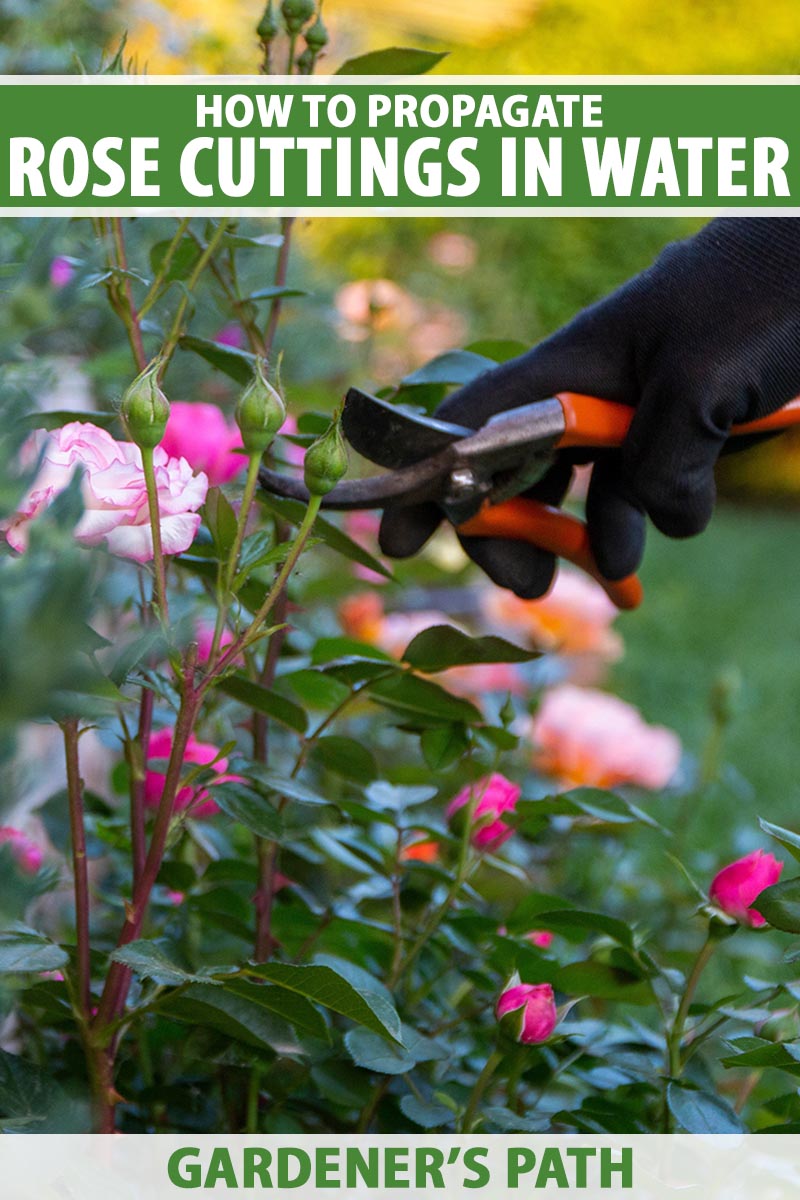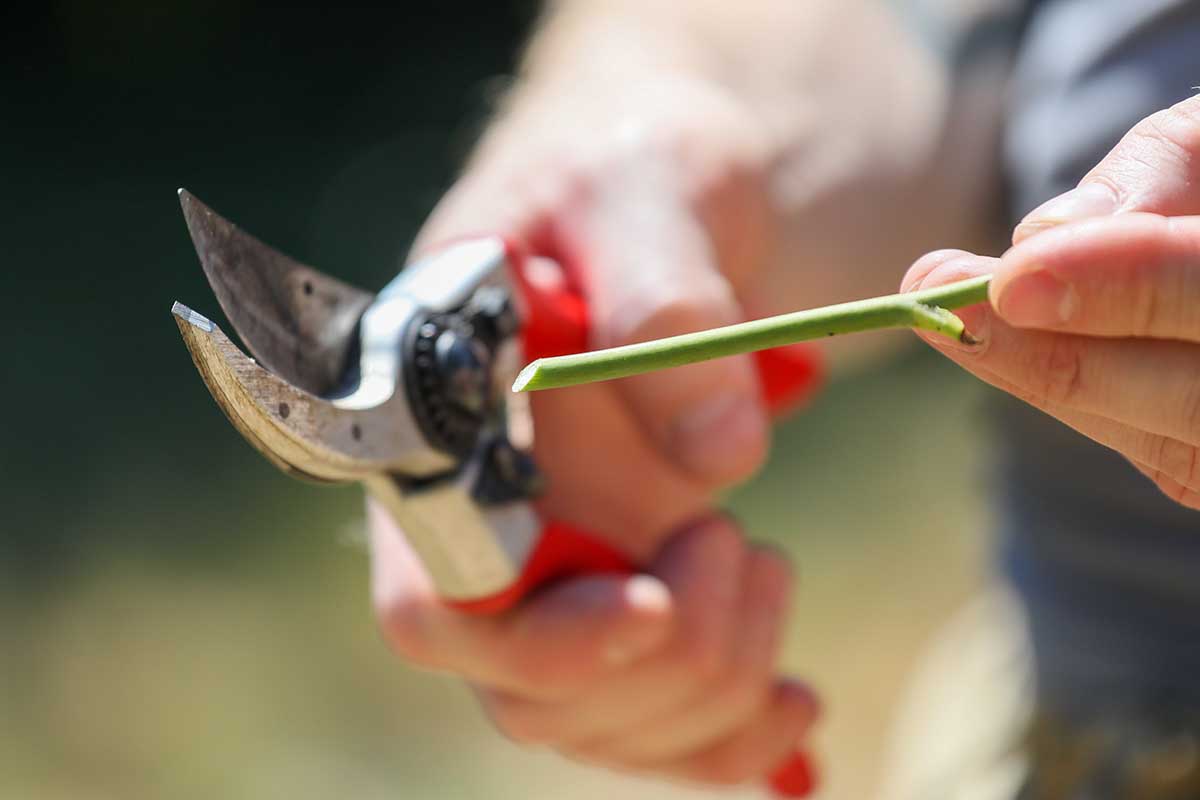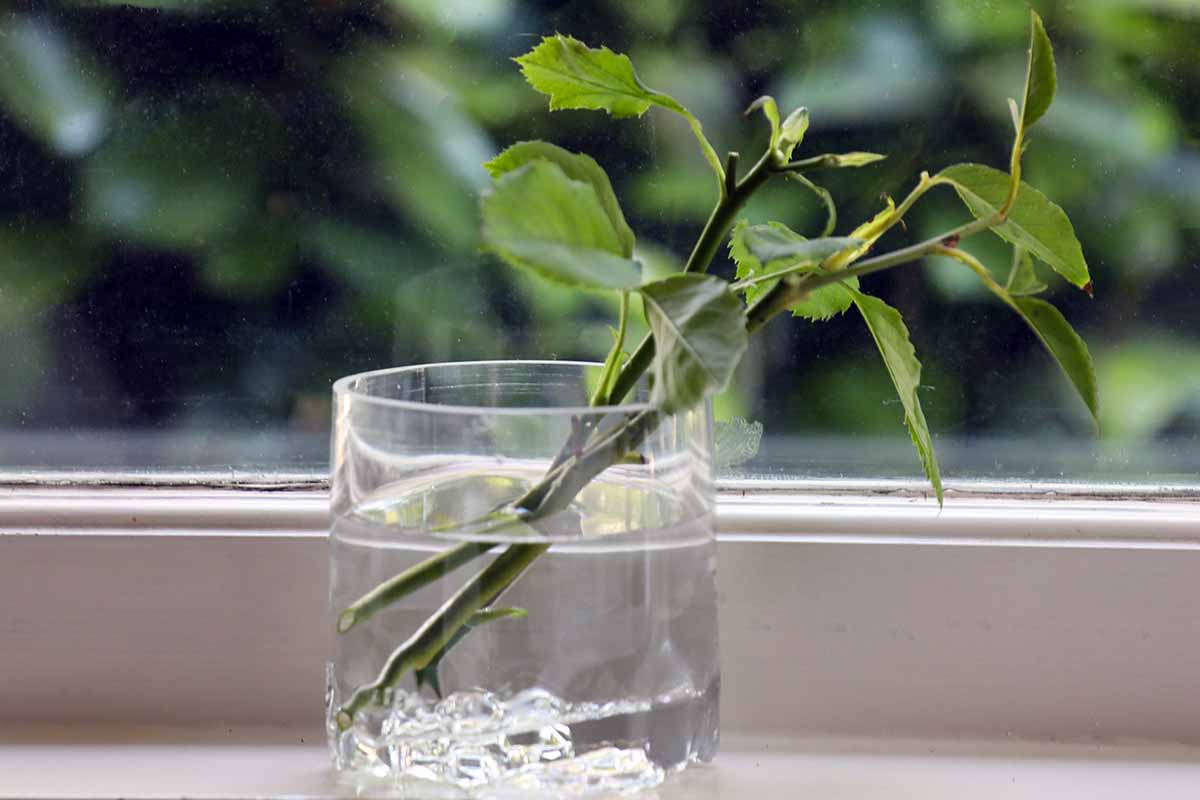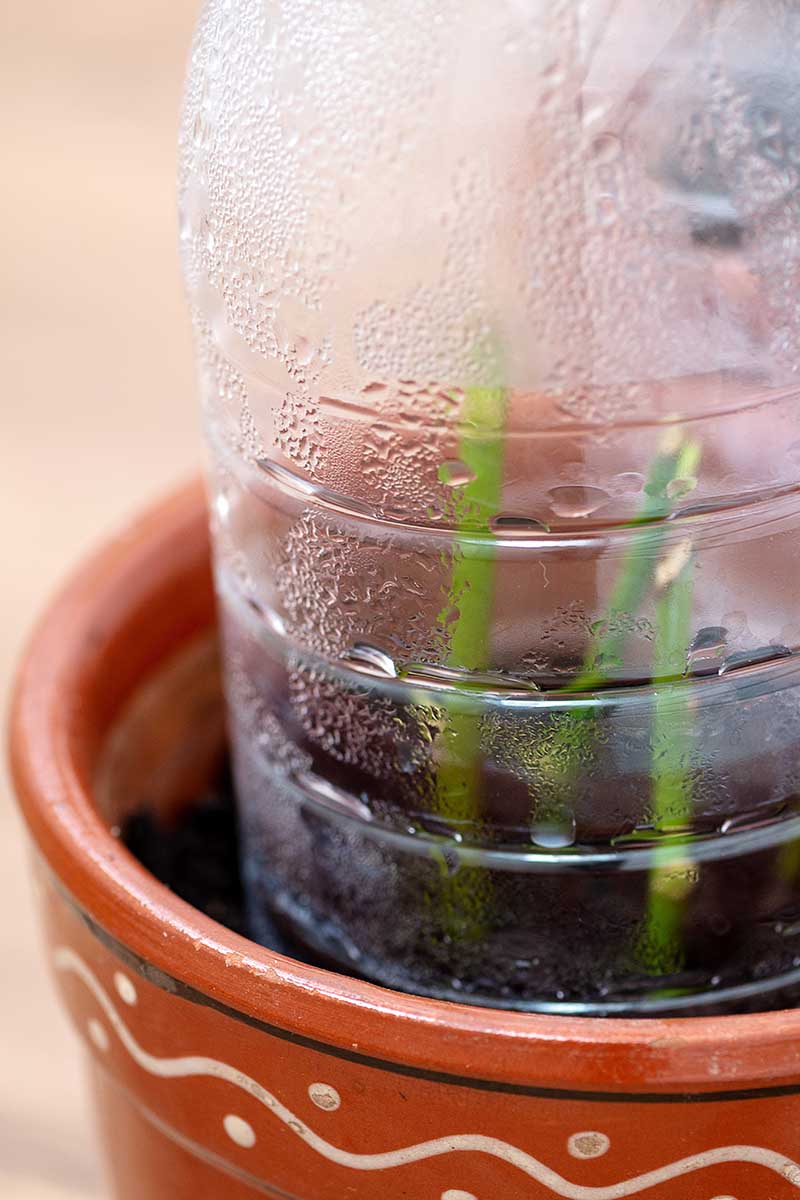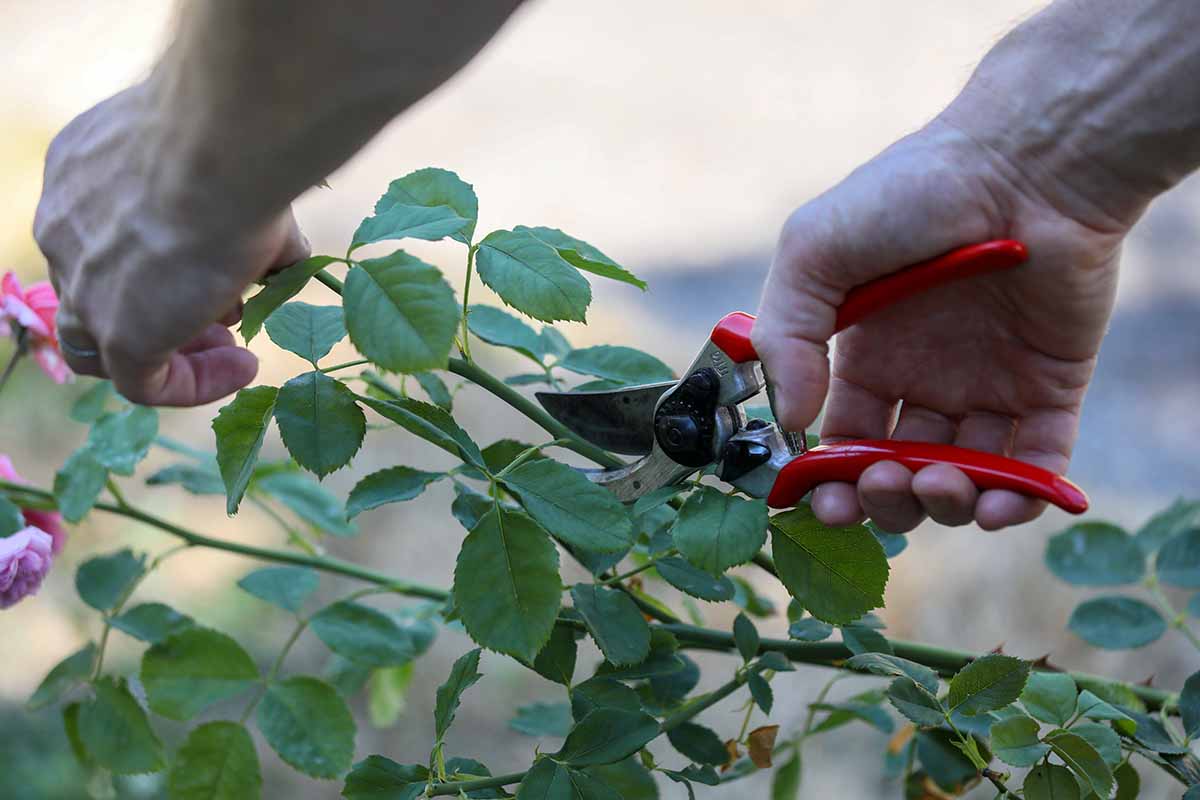Propagating stem cuttings in water happens to be one of the easiest methods. If you’re out trimming your shrubs in the morning, it’s pretty much as simple as tossing some of those ends into a cup of water and keeping the liquid fresh until roots form. We link to vendors to help you find relevant products. If you buy from one of our links, we may earn a commission. That’s what we’re going to go over in this guide. Here’s what we’ll discuss: Stem cuttings from some plants propagate extremely well in water (hello, monstera!), some not so well, and others, like French tarragon, won’t grow roots in water at all. Roses fall firmly into the middle category. It’s not impossible to propagate them in liquid, but they won’t make it easy for you, either. As a general rule, start three cuttings and expect only one to take. Starting rose cuttings in soil is a more reliable method, as it causes less shock for the plant when you transplant it. This method also encourages the development of hardier, sturdier roots. But starting in water is incredibly simple. I think of it this way: if I need to be absolutely sure my cutting will take, I start it in soil. If I’m just casually trimming my roses and want to see if a few will take root, I’ll start them in water.
Be Aware of Laws and Ethics Governing Propagation
Before you jump into propagating your plants, there are some legal and ethical considerations to mull over. Some rose varieties are patented, which means it’s illegal to reproduce them. Petite Knock Outs, for instance, are patented by the breeder Meilland International, and on occasion they have sued – and won judgments against – people who have violated their patents. Most of the time, a patented rose will have a little “R” symbol (®) next to its name, or the tag will specifically state that it’s patented and shouldn’t be reproduced. A trademark symbol (™) doesn’t denote that a patent is held, it simply means that the plant’s name has been trademarked. While it’s unlikely that a patent holder will come searching out a home gardener who just wants one more specimen of their favorite plant, it’s still against the law. Patents are valid for 20 years from the date that they’re issued and unless a new one is granted, it’s fair game at that point. To determine whether a particular cultivar has been patented, you can head to HelpMeFind and search for the name of the rose. Any patents will be displayed on the rose’s information page. They also provide a resource for gardeners who want to exchange cuttings, so you can find some exceptional options to further your collection. But what about those smaller breeders who don’t have the knowledge, time, or even the funds to register a patent on a rose cultivar they create? As a general rule, rose lovers agree not to propagate a particular variety for 20 years after its introduction by a smaller breeder – unless the breeder specifically states it’s okay to reproduce their invention and then it’s usually for home use only. It’s not uncommon among small breeders to share their creations, so feel free to ask. Many of them will be delighted to know that you appreciate their efforts and will be happy to share the love. Even some larger breeders give away plants and permit their cultivars to be propagated by fellow rose lovers for home use. Griffith Buck was famous for his generosity with his roses. There’s no law against reproducing unpatented plants, so only you can decide whether or not you feel right about it.
Take Your Cuttings
Technically any stem you cut from a rose can be propagated in water, but you will have a much higher rate of success with young, pliable, green growth. Avoid the woody, older stems – these are best used for propagation via air layering. Remove all but the top two leaflets. Place the cutting in a clear glass or jar of clean, room-temperature water. The bottom third of the stem should be submerged in water. Once you’ve located some new growth, take a six-inch-long piece from the end of the branch using a sharp, sanitized pair of secateurs. Everyone who knows me knows that I’m a huge fan of Felco pruners, and I carry them with me out into the garden every day. I prefer the F2 model for rose pruning. Felco F2 Pruners It helps to make the cut at a 45 degree angle so the bottom of the stem doesn’t seal flat against the bottom of the container that you place the cutting in. Place the jar out of direct sunlight, but somewhere warm where it will be exposed to bright, indirect light. The average home temperature is ideal, but if you keep the cutting outside, avoid temps below 50 and above 90°F.
Caring for Cuttings
It takes three or so weeks for roots to begin to form, and a few more weeks for them to become large enough to transplant into soil. In the meantime, your job is to change the liquid every single day. Stagnant water is an invitation for fungal and bacterial issues that can put an end to your propagation adventures. Beyond that, just keep an eye on the cutting for any signs of fungal growth, like a brown or black substance on the glass. If you see this, clean the container and refill it with fresh water or move the cutting to a new container with fresh liquid. While you’re cleaning, keep the stem in a cup of water so that it doesn’t dry out. If you don’t see roots forming after about three weeks, wait a few more weeks before giving up. If the end of the cutting starts to turn black, this is a sign that it has died and should be discarded. For those that survive and grow new roots, it’s time to move them to a potting medium.
Transplant into Soil
If you’ve ever successfully managed to start a cutting of any species in water, only to find that it fails once you move it into soil, it’s not your fault. You likely didn’t do anything wrong. The roots that form when a cutting is rooted in water tend to be weaker than those started in soil. After three weeks or so, as long as the cutting still looks healthy and has started to produce new growth, transfer the plant to its new home outdoors after a week of hardening off. Hydrofarm Light Warrior Soilless Potting Mix Make a hole in the potting medium and gently place the rooted cutting into it, tamping down the medium around the stem. Keep the pot indoors in bright, indirect light. Keep the medium evenly moist, but not soggy or wet. Feel free to place a tented plastic bag or a liter bottle with the top cut off over the cuttings to keep them moist. This helps the cutting retain moisture so it doesn’t dry out. If your cutting hasn’t started growing, keep it indoors a bit longer. Hardening off involves taking the young plant outside and putting it in a protected area for an hour on the first day. The next day, place it outside for two hours before bringing it back in again. Add an hour each day for a week to gently acclimate it to the outdoors. At that point, you can plant your rose in the ground. Rooted cuttings can go into the ground anytime of year so long as there are at least six weeks until the first projected frost. The cooler days of fall are usually better for transplanting than the hot days of summer, which can stress young plants. If you took your cutting later in the year or it didn’t root in time for fall planting, keep the potted rose indoors throughout the winter in a sunny spot. Transplant it after hardening it off in the spring after all risk of frost has passed. Whatever your motivation for propagating these plants, rooting stem cuttings in water is a viable method. While it’s less reliable than propagating in soil, it has a time and a place. There are days when I’m out pruning and I don’t want to toss the clippings that I’ve taken, but I don’t have the time to go through the whole planting process. So I toss them in a glass of water and let the magic happen. What about you? What’s your motivation for propagating roses? Share your thoughts with us in the comments section below. Now that you have a new plant on the way, you might be interested in learning more about how to grow and care for roses. If so, here are a few options to check out:
Growing Roses 101: Getting StartedHow to Choose, Raise, and Maintain Beautiful Climbing RosesHow to Choose the Best Location to Grow Roses in Your YardHow and When to Mound Roses for Winter Protection
